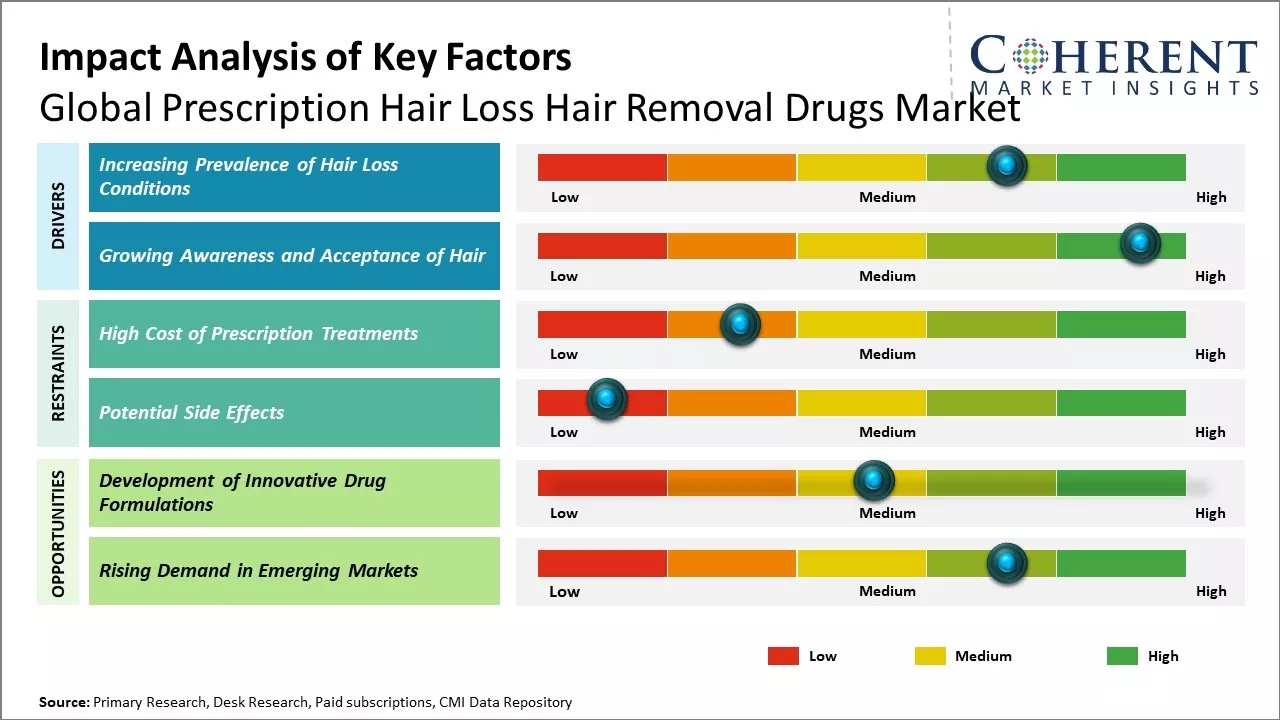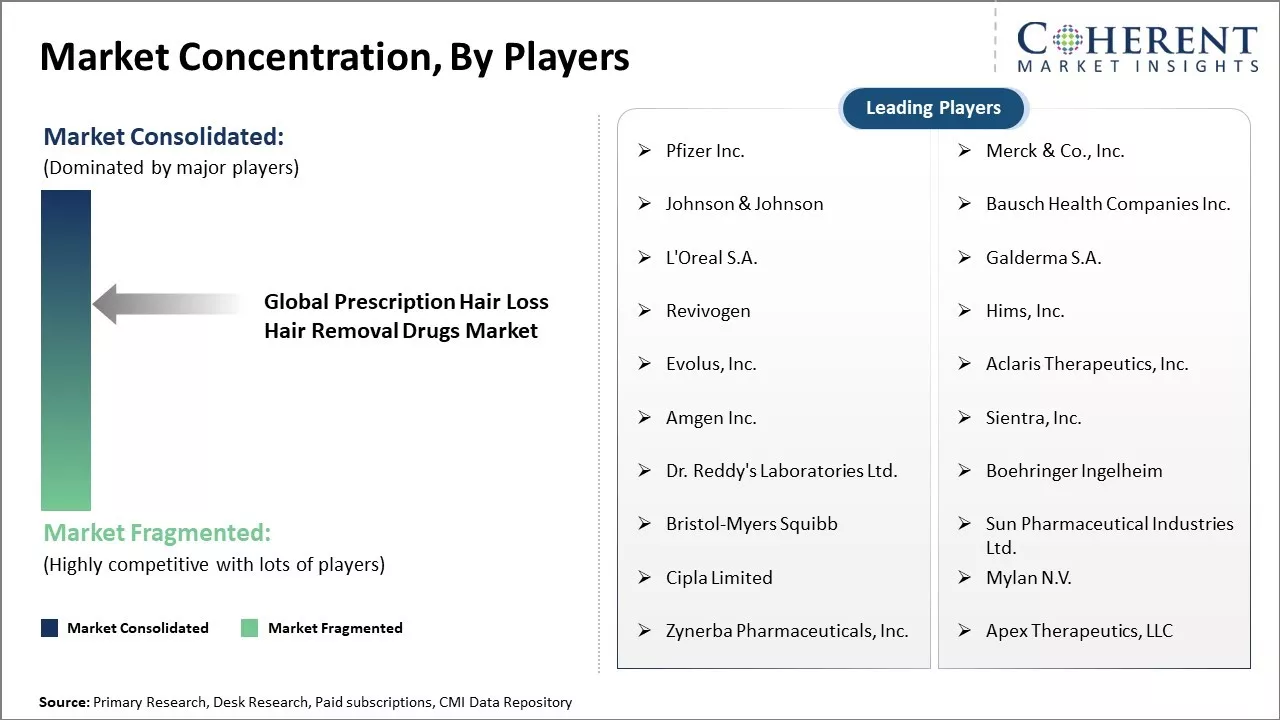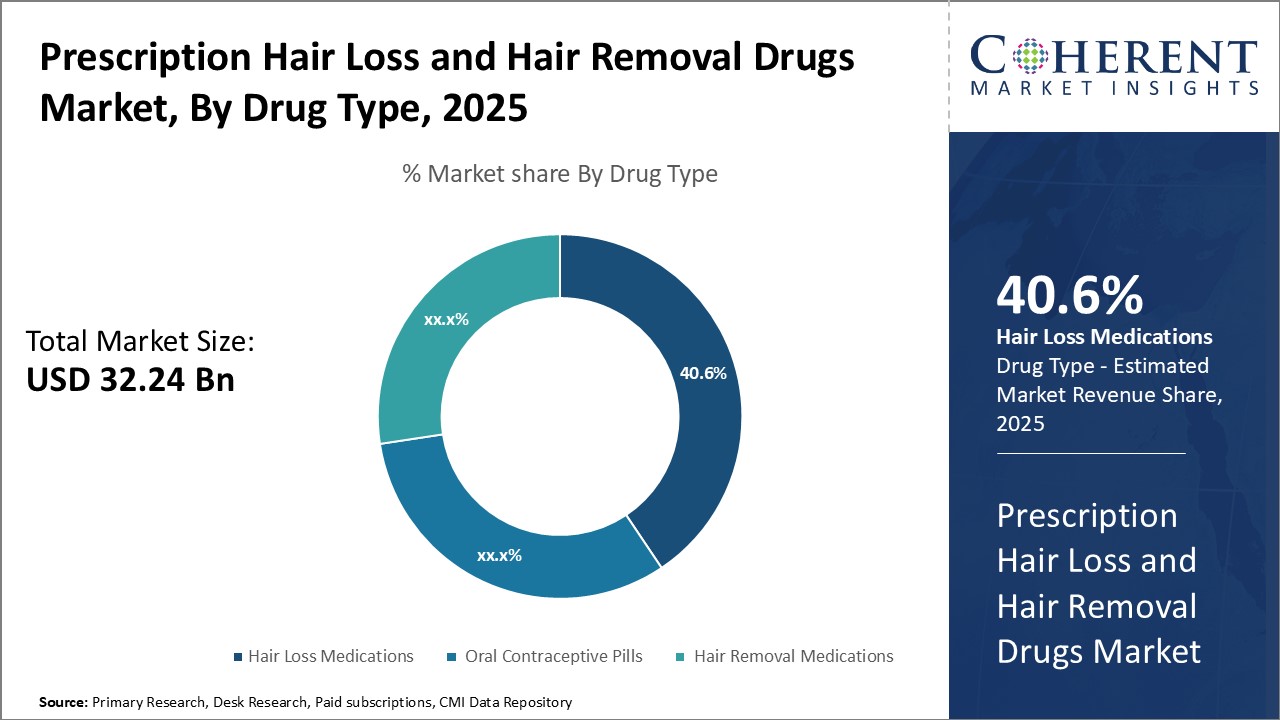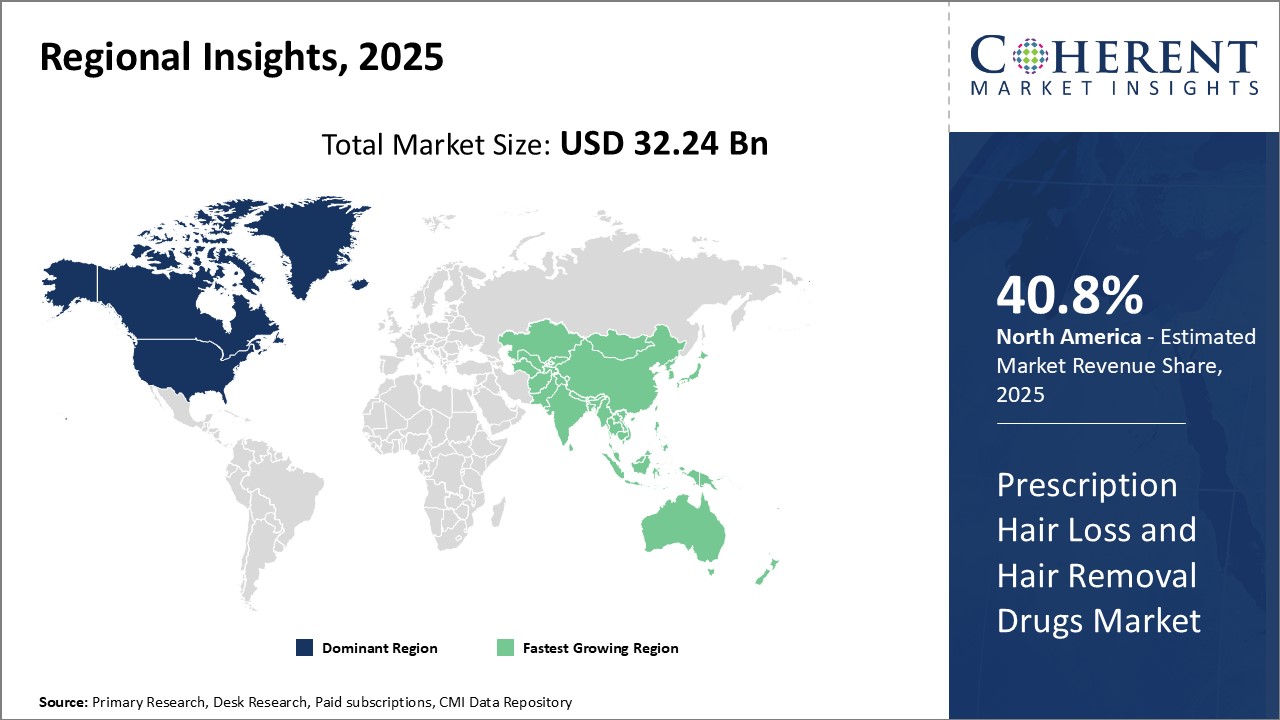Prescription Hair Loss And Hair Removal Drugs Market Size and Trends
Global prescription hair loss and hair removal drugs market is estimated to be valued at USD 32.24 Bn in 2025 and is expected to reach USD 52.14 Bn by 2032, exhibiting a compound annual growth rate (CAGR) of 7.1% from 2025 to 2032.

Discover market dynamics shaping the industry: Download Free Sample
The market has been witnessing positive growth trends due to rising awareness regarding hair loss treatments and availability of various drugs for treating alopecia. Many people are opting for prescription therapies over conventional hair removal methods to avoid skin irritation and other side effects. Availability of these drugs through both offline and online channels has further increased accessibility. Major players actively conducting R&D activities and clinical trials to develop more effective and targeted drugs can drive the market growth during the forecast period.
Increasing prevalence of hair loss conditions
Hair loss has become a more common problem than ever before. As average age of populations in most countries increases worldwide due to decreasing birth rates and increasing life expectancy, there has been increase in prevalence of age-related hair loss conditions. Male pattern baldness or androgenetic alopecia is the most common form of hair loss, primarily affecting men aged 30 years and above. It is estimated to affect nearly 50% of men aged 50. While not as prevalent as male pattern baldness, female pattern hair loss is also rising. Due to constant stress from fast-paced lifestyles and pollution exposure, people are reporting noticeable thinning hair at younger ages as compared to previous generations. Medical conditions like alopecia areata, an autoimmune disorder, have also seen small increases in reported incidences. Rise in certain lifestyle diseases like polycystic ovary syndrome (PCOS) and diabetes that disrupt natural hair growth cycles also contributes to growing hair loss problems. The changes in human hormonal profiles are also linked to increased stresses on hair follicles. With more people retaining their hair well into their 70s and 80s, vulnerability to age-related hair loss persists for longer periods as well. For instance, on July 23, 2023, according to an article published by the U.S. Department of Health and Human Services, more than 50 Million men and 30 Million women gets affected by androgenetic alopecia in U.S. each year.
Market Concentration and Competitive Landscape

Get actionable strategies to beat competition: Download Free Sample
Growing awareness and acceptance of hair
As conversations around body positivity and self-acceptance become mainstream, people have become more comfortable with addressing their hair loss struggles. Where earlier it used to be considered taboo, today hair transplants and medical treatments for hair regeneration are openly discussed on various media platforms. Social media influencers with large followings sharing their hair loss journeys have played a big role in raising awareness and busting myths. Major Hollywood and sports celebrities openly endorsing hair transplants have also provided millions of people permission to stop hiding their hair loss and take action instead. Young people are less stressing about going bald prematurely since viable medication options have become available. Women especially feel more empowered to address hair thinning rather than always trying to hide it with styling products or accessories. Growing vanity trends like man buns and topknots have further normalized styling thin or sparse hair in creative ways. With baldness now being celebrated as a statement rather than something to be ashamed of, people are happier to spend on prescription therapies that offer confidence and self-assurance with cosmetic benefits rather than just covering up the problem. This change in perspective can drive the hair loss drugs market growth.
Key Takeaways from Analyst:
Rising self-consciousness about appearance among both men and women can boost demand for effective hair loss treatment and hair removal options. Growing attention on aesthetics and physical looks has made hair loss a concern, especially in younger populations. High level of discretion offered by prescription medications over OTC treatments can attract more consumers.
North America currently dominates the market due to developed healthcare infrastructure and high consumer affluence. However, Asia Pacific is likely to emerge as the fastest growing regional market with nations like China, Japan and India experiencing increase in hair loss issues and rising medical tourism. Side effects associated with existing drugs and steep treatment costs can hamper the market growth. The market also remains underpenetrated in several developing nations.
Global prescription hair loss and hair removal drugs market can witness opportunities due to continued product innovation and portfolio expansion by key players. Growing collaboration between pharmaceutical companies and dermatologists can also drive the market growth. Providing affordable and customized treatment options especially for fast-growing Asian countries could further stimulate market demand.
Market Challenge - High cost of prescription treatments
Global prescription hair loss and hair removal drugs market growth can be hampered due to high cost of prescription treatments. Currently, two most common prescription drugs for treating hair loss are Minoxidil and Finasteride. However, both of these drugs come at a very high monthly cost for patients. Minoxidil treatment can cost anywhere between US$ 50-US$ 150 per month depending on the strength and brand. Finasteride treatment runs around US$ 60-90 per month. This high recurring cost is a major barrier for many patients and discourages them from seeking and adhering to prescription treatment plans. The high costs especially impact the younger demographic as well as those in developing markets. With such high costs, many patients resort to alternative cheaper but less effective options. Bringing down the treatment costs through generics or new innovative formulations is crucial for market growth.
Market Opportunity- Development of innovative drug formulations
Global prescription hair loss and hair removal drugs market can witness growth opportunities from development of more innovative drug formulations. Currently available options like topical minoxidil solutions and finasteride pills have certain limitations. The development of advanced drug delivery mechanisms like nanotechnology-based topical solutions, mini-pills, transdermal gels, and patches can help address some of these limitations. For example, a minoxidil transdermal gel or patch may provide similar efficacy with less frequent applications. Nanoparticle-based topical formulation of finasteride may help in better penetration and delivery of the drug to hair follicles. Such innovative formulations have the potential to not only enhance treatment efficacy but also improve patient convenience and compliance. This can expand the consumer base by attracting more new patients. Focused R&D on next-generation drug formulations can drive the market growth. For instance, on June 2, 2022, Cynosure, a provider of laser and RF (radio frequency) technologies, launched the Elite iQ aesthetic workstation for laser hair removal. Featuring patented Skintel technology, the Elite iQ platform is designed to be suitable for all skin types, offering personalized laser hair removal treatments.

Discover high revenue pocket segments and roadmap to it: Download Free Sample
Insights, By Drug Type - Growing awareness about hair fall treatment
In terms of drug type, hair loss medications segment is estimated to contribute the highest market share of 40.6% in 2025, due to growing awareness among the masses about various treatment options available for hair fall. Earlier, hair fall was seen as a natural occurrence with age. However, with readily available information online and increasing visibility of hair fall solutions via advertising, people are better informed now about the medical causes behind excessive hair shedding. This has encouraged more individuals experiencing hair thinning to seek clinical evaluation and prescription medication rather than to ignore the problem. The adoption of hair loss drugs is further boosted by demand for non-invasive, low-maintenance remedies as compared to alternatives like hair transplants. Their easy oral dosage form and relatively affordable prices have made them a popular first-line treatment choice.
Insights, By Gender - Emphasize improved vitality and youthful energy.
In terms of gender, male segment is estimated to contribute the highest market share of 52.6% in 2025, owing to escalating peer pressure on physical attractions. For many modern-day men, a full head of hair is considered integral to their masculine appeal and social value. Thinning hair or balding impacts their self-confidence and perception of aging. To maintain a youthful, attractive look, these people actively invest in appearance-boosting measures like hair loss drugs. The marketing strategies adopted by pharmaceutical companies also center around notions of enhanced virility linked to a full hair cover. Testimonials emphasizing how prescription medication helped regain dense hair reinforce the segment's demand.
Insights, By Application - Extensive use period for chronic cases
In terms of application, chronic hair loss segment is estimated to contribute the highest market share of 53.6% in 2025, due to its prolonged treatment cycle. Chronic hair fall refers to a continuous shedding pattern persisting for over six months triggered by issues like genetics, stress, or medical conditions. While acute hair loss is often temporary, chronic cases need long-term suppression of the root causes. This sustains the consumption of prescribed drug therapies for years until the hair follicles recover completely or stabilize. The extensive use period compared to acute hair fall applications secures higher revenue streams for chronic hair loss medications. It remains the key application field boosting demand and sales volume in the prescription drugs segment.
Regional Insights

Need a Different Region or Segment? Download Free Sample
North America dominates the global prescription hair loss and hair removal drugs market with an estimated market share of 40.8% in 2025. The large population of the region dealing with hair loss issues can drive the market growth. North America has a highly developed healthcare sector with widespread medical insurance coverage facilitating easy access to such drugs. Several top pharmaceutical companies developing hair loss treatments have their headquarters in the U.S., allowing for strong product presence across the region. However, with generally high pricing of prescription drugs in North America, the market witness a shift towards over-the-counter, low-cost hair removal options, thus, marginally slowing its market growth.
Asia Pacific region, especially China and India, is emerging as the fastest-growing market for prescription hair loss hair removal drugs. Rapid expansion of the middle-class population concerned with personal grooming and aesthetics can drive market growth. Several local pharmaceutical firms backed by generics manufacturing capabilities have entered the market. This has improved product availability while maintaining competitive pricing, making medications more affordable compared to the West. Thus, these countries are generating the maximum demand globally outside of North America. Furthermore, increasing medical tourism from developed nations to access cheaper treatment in Asia Pacific can also drive the market growth. Growing awareness about new products through extensive digital and e-commerce penetration in major Asian markets can propel the industry's growth in the region.
Market Report Scope
Prescription Hair Loss and Hair Removal Drugs Market Report Coverage
| Report Coverage | Details | ||
|---|---|---|---|
| Base Year: | 2024 | Market Size in 2025: | USD 32.24 Bn |
| Historical Data for: | 2020 To 2024 | Forecast Period: | 2025 To 2032 |
| Forecast Period 2025 to 2032 CAGR: | 7.1% | 2032 Value Projection: | USD 52.14 Bn |
| Geographies covered: |
|
||
| Segments covered: |
|
||
| Companies covered: |
Pfizer Inc., Merck & Co., Inc., Johnson & Johnson, Bausch Health Companies Inc., L'Oreal S.A., Galderma S.A., Revivogen, Hims, Inc., Evolus, Inc., Aclaris Therapeutics, Inc., Amgen Inc., Sientra, Inc., Dr. Reddy's Laboratories Ltd., Boehringer Ingelheim, Bristol-Myers Squibb, Sun Pharmaceutical Industries Ltd., Cipla Limited, Mylan N.V., Zynerba Pharmaceuticals, Inc., Apex Therapeutics, LLC |
||
| Growth Drivers: |
|
||
| Restraints & Challenges: |
|
||
Uncover macros and micros vetted on 75+ parameters: Get instant access to report
Market Segmentation
- By Drug Type Insights (Revenue, USD Bn, 2020 - 2032)
-
- Hair Loss Medications
- Oral Contraceptive Pills
- Hair Removal Medications
- By Gender Insights (Revenue, USD Bn, 2020 - 2032)
-
- Male
- Female
- By Application Insights (Revenue, USD Bn, 2020 - 2032)
-
- Chronic Hair Loss
- Acute Hair Loss
- By Route of Administration Insights (Revenue, USD Bn, 2020 - 2032)
-
- Topical
- Oral
- Injectable
- By Distribution Channel Insights (Revenue, USD Bn, 2020 - 2032)
-
- Hospital pharmacies
- Retail pharmacies
- Online pharmacies
- By Regional Insights (Revenue, USD Bn 2020 - 2032)
-
- North America
- U.S.
- Canada
- Latin America
- Brazil
- Argentina
- Mexico
- Rest of Latin America
- Europe
- Germany
- U.K.
- Spain
- France
- Italy
- Russia
- Rest of Europe
- Asia Pacific
- China
- India
- Japan
- Australia
- South Korea
- ASEAN
- Rest of Asia Pacific
- Middle East
- GCC Countries
- Israel
- Rest of Middle East
- Africa
- South Africa
- North Africa
- Central Africa
- North America
- Key Players Insights
-
- Pfizer Inc.
- Merck & Co., Inc.
- Johnson & Johnson
- Bausch Health Companies Inc.
- L'Oreal S.A.
- Galderma S.A.
- Revivogen
- Hims, Inc.
- Evolus, Inc.
- Aclaris Therapeutics, Inc.
- Amgen Inc.
- Sientra, Inc.
- Reddy's Laboratories Ltd.
- Boehringer Ingelheim
- Bristol-Myers Squibb
- Sun Pharmaceutical Industries Ltd.
- Cipla Limited
- Mylan N.V.
- Zynerba Pharmaceuticals, Inc.
- Apex Therapeutics, LLC
Share
Share
About Author
Ghanshyam Shrivastava - With over 20 years of experience in the management consulting and research, Ghanshyam Shrivastava serves as a Principal Consultant, bringing extensive expertise in biologics and biosimilars. His primary expertise lies in areas such as market entry and expansion strategy, competitive intelligence, and strategic transformation across diversified portfolio of various drugs used for different therapeutic category and APIs. He excels at identifying key challenges faced by clients and providing robust solutions to enhance their strategic decision-making capabilities. His comprehensive understanding of the market ensures valuable contributions to research reports and business decisions.
Ghanshyam is a sought-after speaker at industry conferences and contributes to various publications on pharma industry.
Missing comfort of reading report in your local language? Find your preferred language :
Transform your Strategy with Exclusive Trending Reports :
Frequently Asked Questions
EXISTING CLIENTELE
Joining thousands of companies around the world committed to making the Excellent Business Solutions.
View All Our Clients
